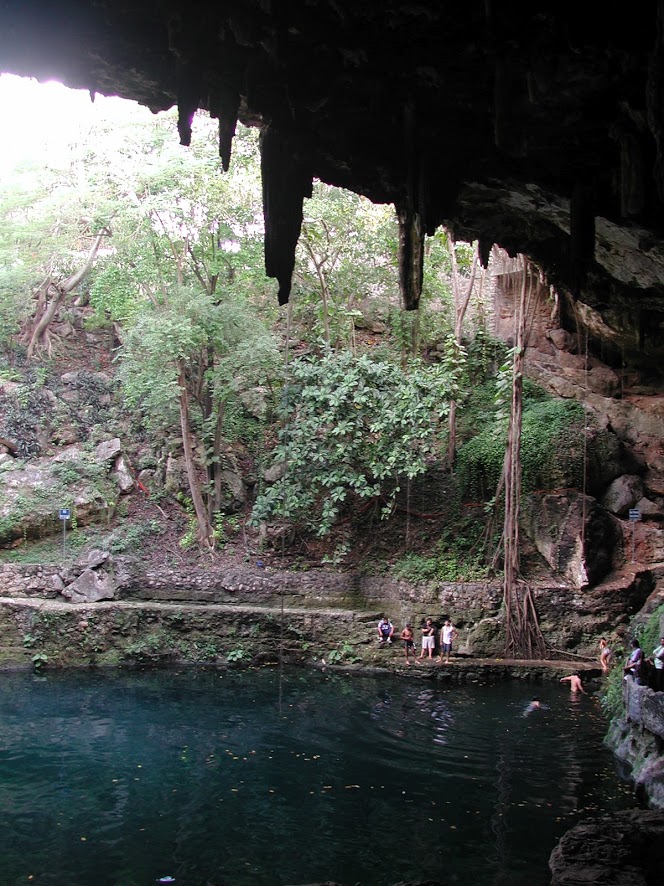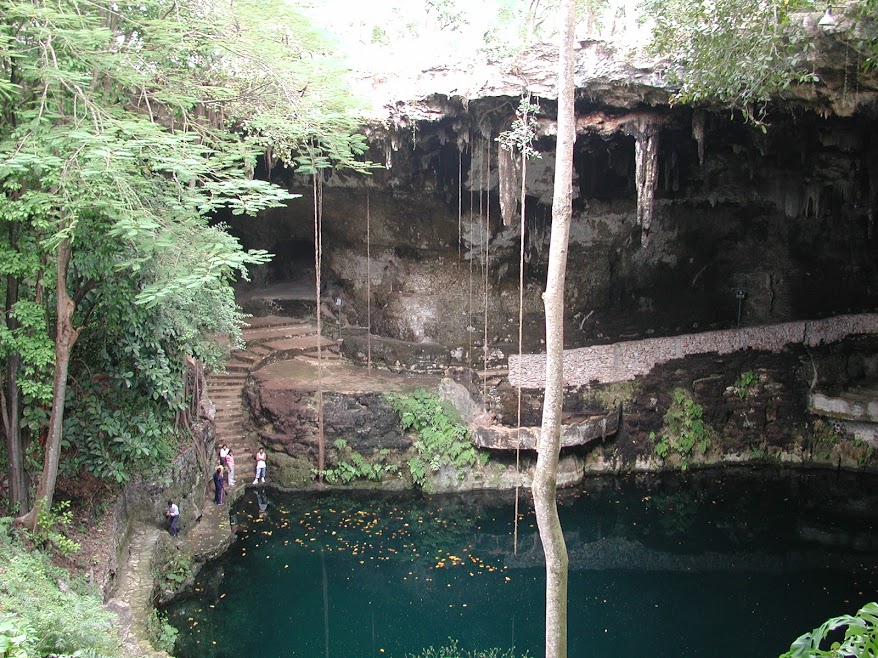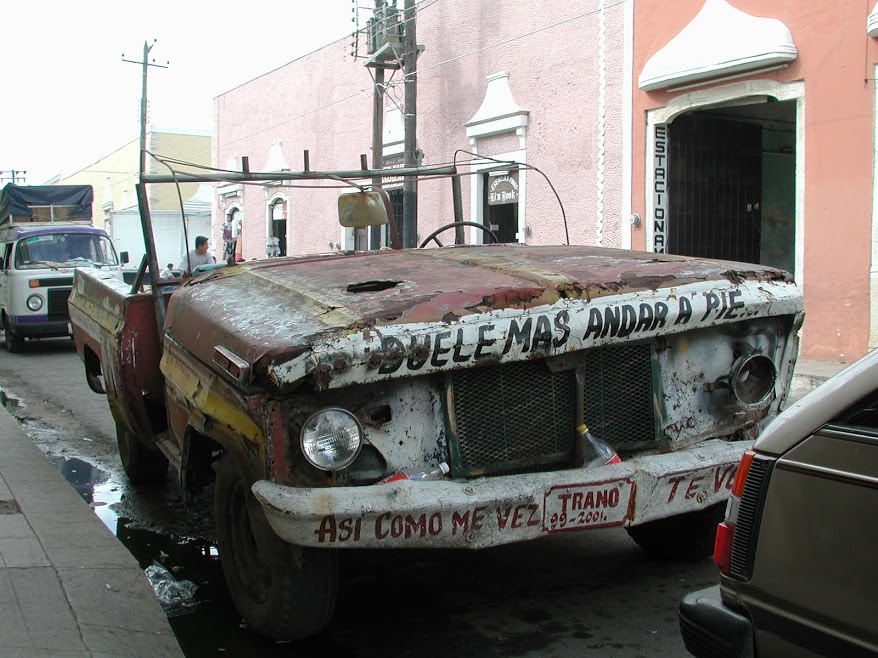Valladolid, Yucatán, México
27 December 2001In 1543, Francisco de Montejo (the nephew of Mérida’s famous Francisco de Montejo) descended on the ceremonial centre of the Zací (Hawk) Maya, waging war on the Cupules, a group of Maya that hadn’t taken kindly to the Spanish conquistadors. When the battle was done and the town had been razed, he renamed it Valladolid in honour of the Spanish city of the same name. Today, Valladolid is one of the most beautiful colonial cities in the Yucatán, with a mix of Spanish and Maya influences. Maya from local pueblas and from the city sell traditional huipiles near the plaza downtown. The city is still roughly centered on the Cenote Zací that was the ceremonial centre of the original Mayan settlement.

The cenote is one of the most beautiful I’ve ever seen. To get to it, you hike down a passage into a cavern, then wind your way down the side to get to water level. The water is a deep turquoise colour, and is absolutely crystal clear. In the shallow areas, you can easily see fallen stalactites lying 30 metres below on the bottom. In the deep parts, you won’t see the bottom—it’s more than 100 metres deep. The same little blind fish that are present in the cenote at Dzibilchaltún will nibble your toes in this cenote as well.
Above the cenote is a little zoo with spider monkeys, who spend most of their afternoon playing with toys, and getting fed potato chips by laughing groups of kids. What was more interesting, however, was that they had a raccoon in the zoo. You don’t see them in México at all, and most people we asked didn’t know what the Spanish word for it was, until an old man we ran into told us it was mapache.
The main plaza of the city is gorgeous. With ornate lamp posts, hanging baskets full of flowers, and beautiful hedges, it was the Yucatán’s answer to Victoria. The streets downtown are kept immaculately clean by a crew of street cleaners who run through the streets every morning at 5 am. The government of Spain has apparently deemed Valladolid to be one of the most Spanish cities in the Americas, and donates money to help in its preservation.

Probably the most exciting thing that happened while we were there was the rain. We had gone off in search of what is supposed to be an absolutely amazing cathedral and graveyard somewhere in the southwestern part of the city. In typical Mexican fashion, everyone we talked to was able to tell us in approximately what direction it was, so we were able to slowly make our way there stumbling randomly from one Vallisoletana to the next. We never did find it, but not for any lack of determination, but because it started to rain. Now, when I say rain, I don’t mean the rain we get in Victoria. I don’t even mean Vancouver rain. To fully appreciate a Yucatecan rain storm, you really need to experience one. Imagine the streets filling with water, then overflowing onto the sidewalks until the whole city is two feet deep in rainwater. We did the only thing we could do: jump into a corner store. The guys in the store reacted the same way any other Mexicans all over the country would react: toss over a couple chairs and invite us in to watch some TV. We bought some cookies and juice and sat for 45 minutes or so, watching the water level in the street outside rise closer and closer to the edge of the door before we finally decided that we were going to make a break for it, only stopping once for a slice of cheesecake in a bakery along the way back to the hotel.
Valladolid is also famous for the cenote at Dzitnup, about 10 km out of town. While we never did make it there, we heard some amazing stories about it from Nick, an Irishman from Cork we met in San Cristóbal de las Casas. What is so incredible about it is that it’s at the bottom of a dark cavern, with a small opening in the roof. At the right time of day, the sun shines through this opening and into the turquoise waters of the cenote, making it apear as though you’re bathing in light. The actual name of the cenote is Kiken which is Yucatec Maya for ‘pig,’ because the cenote was originally discovered by a farmer whose his pig had fallen in through the hole in the roof.
Valladolid is also famous for its uprisings. What transpired in Valladolid in June of 1910 helped to spark the Mexican Revolution that erupted in the rest of the country that November when Francisco Madero flew across the border into Piedras Negras, Coahuila. The revolution wasn’t over until 1920; but as they say, the opening chapters were written in blood, here in Valladolid.

'It hurts more to walk'
Unhappy with Spanish control of a land they considered their own, a small band of revolutionaries had worked together for months, planning the overthrow of governor Moñoz Aristegui. On the night of June 3rd, 1910, all those committed to the plan met in the Plaza de la Santa Lucia at midnight. Under the command of Ruz Ponce and José Kantún, one group stormed the police quarter, killing the guard outside and taking everyone else prisoner. Another group, led by Claudio Alconcer and Atilano Albertos took the office of the Mexican Guard, killing the Sergeant of the Guard, Facundo Gil. The governor, Felipe de Regil, asleep in bed at the time, woke up to the sound of gunfire outside in the streets. He immediately jumped out of bed and, a gun in each hand, ran into the street firing on the revolutionaries. He fought bravely until the end, when he was finally killed and left lying in the street.
At this point, there was no turning back for the insurgents. They now had the support of nearly the entire city, and within three days had amassed an army of no less than 1500 men, armed with guns and machetes. Most had no military training. Local landowners provided weapons, ammunition and food.
In Mérida, this uprising had not gone unnoticed. While the locals were preparing in Valladolid, the government had sent a column of 65 men eastward with 300 guns, recruiting villagers along the way. Under the command of Colonel Ignacio Lara, they marched easward to Tinum, 12 km outside of Valladolid, where they waited for reinforcements to arrive. The cannons of Morelos arrived in Valladolid on the 7th. On the 8th, Lara led his men to the outskirts of the city, where, at dawn on the 9th of June, they began the assault on Valladolid. A batallion of 600 federal troops arrived on the 10th. Poorly equiped, untrained, and out of ammunition, the rebels fell under the three ferocious onslaughts. The death tolls were high on both sides: more than 100 revolutionaries and over 30 government soldiers had been killed. This was the highest balance of deaths of any battle ever fought in México, and would remain so until the Revolution began that November.
The leaders of the revolt were eventually rounded up, tried and sentenced to death. In the courtyard of the Shrine of San Roque, Kantún, Albertos, and Bonilla faced the firing squad. That November, Francisco Madero launched the Mexican Revolution, and by the following April, 17000 people had taken up arms against Porfirio Diaz and his government. The rest is history.